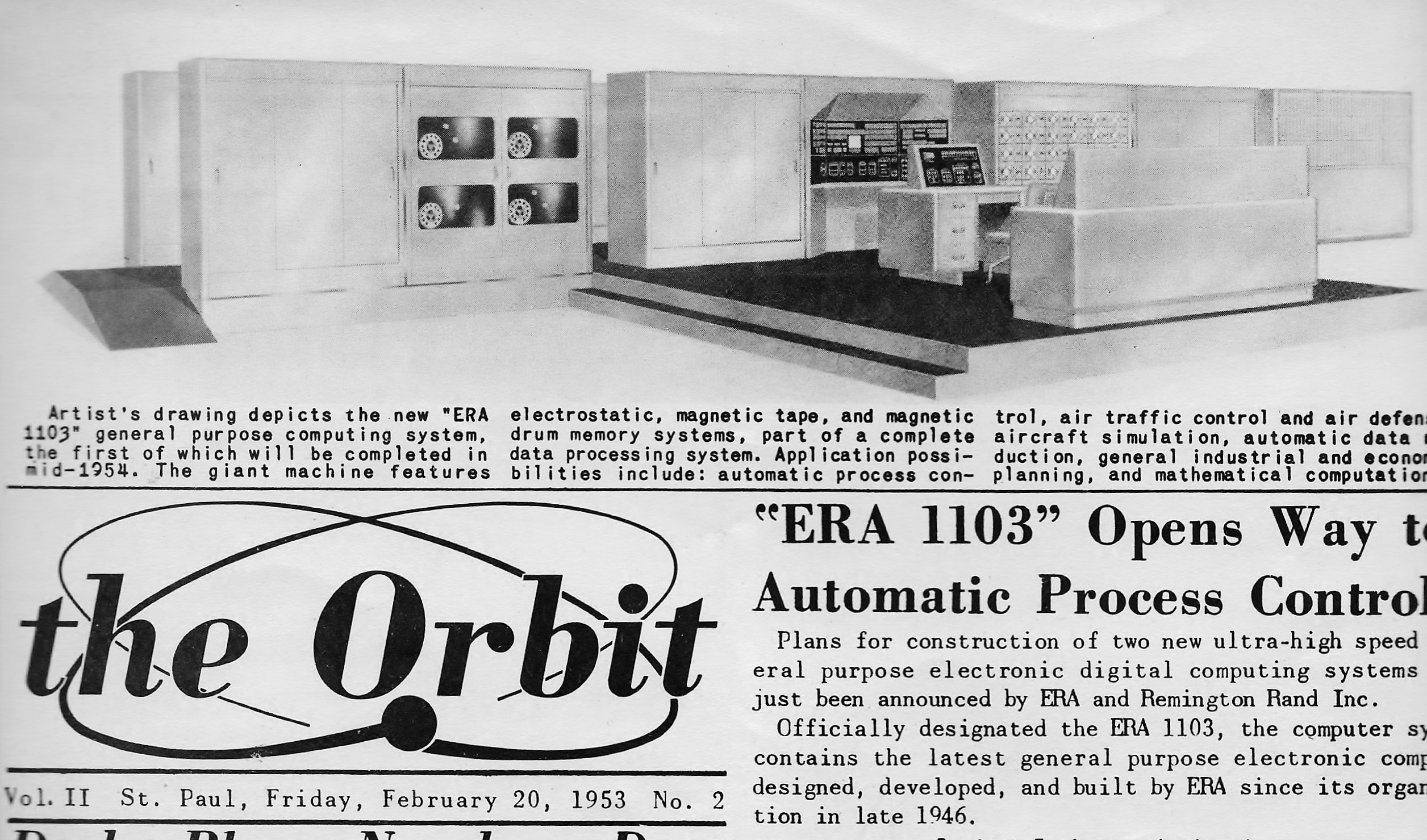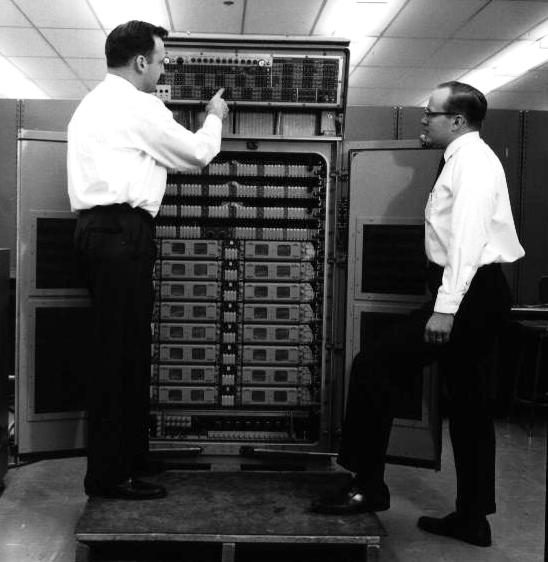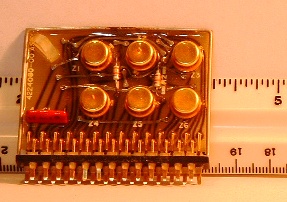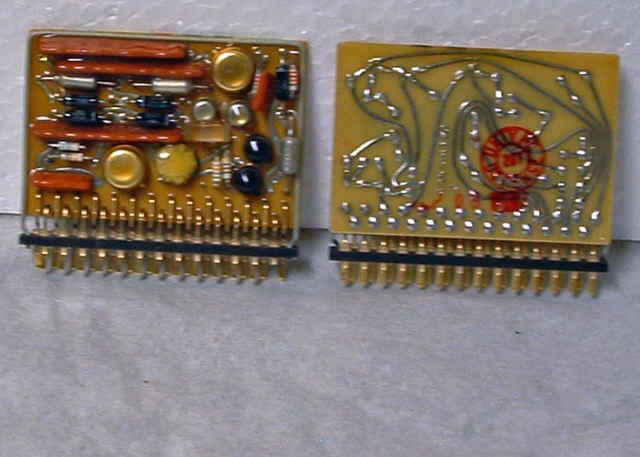

Information Technology (IT) Pioneers
Retirees and former employees of Unisys, Lockheed Martin, and their heritage companies
36bit Computers, Chapter 56
1. Introduction
 The first 36-bit machine was the ERA 1103 (Atlas II). The 1103A was
a technology upgrade to be called the UNIVAC SCIENTIFIC. This
newsletter dated February 28, 1953 has an artist's drawing of the
1103.
The first 36-bit machine was the ERA 1103 (Atlas II). The 1103A was
a technology upgrade to be called the UNIVAC SCIENTIFIC. This
newsletter dated February 28, 1953 has an artist's drawing of the
1103.
The 1104 used 1103A technology with a 30-bit ISA thus isn't included on this page. The 1105 was a technology upgrade of the 1103A, leading to the 1107 series as described in the Processors, Commercial chapter. A video summary runs about 15 mins, presented by the Computer History Archives Project (CHAP), https://youtu.be/WbfCJZXxvw4.
2. 36-bit Computer Descriptions
Many thanks to the Bit Savers website, they have a lot of document information about these early systems. Read the History and Evolution of the 1100-2200 mainframe computers written by Unisys Fellow Richard Petschauer.
2.1 1103 and 1103A
By Harry Wise - The 1103 stepped up to a 36 bit word length. The difference - the 24 bit ISA contained an instruction and the drum address of the operand. The 36 bit ISA had an instruction, the operand address, and the address of the next instruction. This innovation meant that the assembler could strategically place the next instruction around the drum so that it would be under the read heads at the instant that the current instruction finished execution. These machines used logic implemented with vacuum tubes. After delivering twenty-seven 1103 based systems, one 1104 system, and ten 1105 drum based systems, UNIVAC began the 1100 commercial series with the 1107 transistor/core memory based system and a different ISA that had some characteristics of the 30-bit NTDS computer architecture.
George Gray and Ron Q. Smith of Unisys co-authored three articles on the history of Sperry computers published in the IEEE Annals of the History of Computing. George provided the following 1103 and 1105 customer information. [lab]
| S/N | Customer | S/N | Customer |
| 1 | Consolidated Vultee Aircraft | 2 | U.S. Air Force-Eglin AFB |
| 3 | White Sands Missile Range | 4 | Ramo Wooldridge, then U of Minnesota in March of 1958 |
| 5 | Westinghouse Electric | 6 | Johns Hopkins University - ORO |
| 7 | U.S. Air Force-Wright Center | 8 | NACA Lewis Research Center |
| 9 | UNIVAC St. Paul Engineering | ||
| 10 | Lockheed Aircraft | 11 | Boeing Aircraft |
| 12 | U.S. Air Force Missile Center | 13 | Johns Hopkins University - APL |
| 14 | U.S. Army Engineer Laboratory then Johns Hopkins Univ. - ORO | ||
| 15 | Ramo Wooldridge | 16 | Westinghouse Electric |
| 17 | Johns Hopkins University - ORO | 18 | U.S. Army Signal Corps |
| 19 | White Sands Missile Range | 20 | U.S. Air Force Missile Center |
| 22 | Lockheed Missile Division | 23 | U.S. Air Force – Wright Center |
| 24 | U.S. Navy | 26 | U.S. Navy |
| 27 | Lockheed Missile Division | S/N 21 and S/N 25 aren't known by our information sources |
2.2 1105.jpg)
This 1955 System Console photo is from the 'Bit Savers' collection. LABenson recognizes the person at the console as Bill Klingner who went on to form his own company, Northport Engineering. I met Bill in the late 80s when he and I were in the same investment club.
| S/N | Customer | S/N | Customer | |
| 1,2 | U.S. Bureau of the Census | 3 | U. of North Carolina | |
| 4 | U.S. Air Force - Air Materiel | 5 | Illinois Institute of Technology | |
| 6,9 | U.S. Air Force - ROAMA | 7,8 | U.S. Air Force – Supply Center | |
| 10 | Government of Brazil |
Thanks to George Gray for this customer delivery information.
![]()
2.3 CP-667 - by Jim Rapinac, Lowell Benson, Larry Bolton, Jorgen Andersen, and Larye Parkins.
The CP-667 was a new design based on Don Ream's NTDS requirements design, it wasn’t based on a commercial Univac computer. It was slated for use on the Navy's Mobile OPCON program which was subsequently canceled. Not sure what happened to this program. Only Eric Swenson, Vern Leas, and Don Ream knew.
 The cabinet was based on the
AN/USQ-20 cabinet because I moved many basic Q20 mechanical components
from the Q20 crib to the CP-667 crib! Some components like gussets and
side plates were new designs because the CP-667 cabinet was slightly
larger than the Q20 due to memory size, 16 I/O channels, thin film memory,
etc. Mechanical Design Engineers included Les Nesler, Seri Yermolenko,
and Tony Just, who was also involved in the circuit design. Hy Osofsky
and Glen Kregess were the key logic designers, shown here with a CP-667,
circa 1963.
They
reported to Manager Finley McLeod who worked for Director George Raymond.
The cabinet was based on the
AN/USQ-20 cabinet because I moved many basic Q20 mechanical components
from the Q20 crib to the CP-667 crib! Some components like gussets and
side plates were new designs because the CP-667 cabinet was slightly
larger than the Q20 due to memory size, 16 I/O channels, thin film memory,
etc. Mechanical Design Engineers included Les Nesler, Seri Yermolenko,
and Tony Just, who was also involved in the circuit design. Hy Osofsky
and Glen Kregess were the key logic designers, shown here with a CP-667,
circa 1963.
They
reported to Manager Finley McLeod who worked for Director George Raymond.
I was the PERT planning engineer for the CP667 and we only
built one computer, much to our disappointment. I placed the first Purchase Order
(PO)
for a wire wrap machine for the back panels. The CP-667 was years ahead
in technology. This design was the first UNIVAC computer to use Integrated
Circuits (ICs) which were packaged in TO-5 cans – looked like
big transistors but had 10 leads instead of three.
The main memory used a new core, smaller than previous cores, which we obtained
from General Ceramics, Keasby, NJ. I negotiated the price and delivery
terms for this smaller core and the memory planes used a new core stringing
machine.
Also, the CP-667 was the first product to use the automatic wire wrap machine. Larry Reid was the Mfg. Director
and he was reluctant to sign the PO but finally he did. Regards;
Rapp
Photo at the right came from Curt Nelson’s files. [lab]
Finley McLeod led the design team developing the CP-667. It had 131k of directly addressable core memory. Although it was designed as a 36-bit machine, the flip of a switch on the control panel had this unit revert to 30-bit operation.
I, Lowell, was a computer operator in plant 1 from 1963 to '66. We had a CP-667 there and I ran a few programs on it. My memory is that I was told that there was also one in a center in San Diego plus one that was supposed to go aboard a ship - but damaged in a fire thus became spare parts. Because of my recollection and that the Sperry Univac Computer Genealogy chart showing the number (3), I was thinking that Boslaugh's book with qty 1 CP-667 is in error. There was just one for the Navy when the 2nd was in the fire. The third stayed in St. Paul, used for a variety of internal projects.
This machine and the one from San Diego were in the Eagan METC during the 80s according to Gene Achterberg and Dr. Carl Glewwe. Carl also told me that since they couldn’t sell these computers, his job was to use them on various projects to recover some of the costs. David P. Andersen told me that some of their early Voice research software used the CP-667 before they transitioned to the 1616 mini-computers. Earl Vraa chipped in that the early Computer Aided Design work used the CP-667 computer. [LABenson]
According to one of my listings, the CP-667 used DTL gates manufactured using hybrid techniques. Those were contained in 10-lead TO-5 cans. The CP-667 Diode Hybrid Gates were documented in procurement specs numbering 7900032 through 7900043. [Larry Bolton]
There are six of these TO-5 cans on the 27-pin card shown on the right. [lab]
[from Larry Bolton] I found the exact card you have the photos of
in our archives. It is a 4224080 card and has six
 gold colored 10-lead TO-5 can devices on it. I looked at the parts and
got part numbers. There are three Motorola SC90 parts, one Motorola
SC92 part, and two Motorola SC94 parts. All were made in 1963.
gold colored 10-lead TO-5 can devices on it. I looked at the parts and
got part numbers. There are three Motorola SC90 parts, one Motorola
SC92 part, and two Motorola SC94 parts. All were made in 1963.
I went to the vault and got the microfilm for what the cross reference
chart mentioned above said were the procurement specs for the CP-667
hybrids. I found three drawings. The 7900034 shows that a Motorola SC92
is the source, the 7900035 shows that a Motorola SC93 was the source,
and the 7900036 shows that a Motorola SC94 was the source. By extension,
it can be assumed that the SC90 would have been the source for a 7900032.
These drawings were generated to support Lee Granberg in 1962. The SC92
device is nine 1N914 discrete devices along with four 1K resistors in
the form of a 1-1-1-2 diode gate. The SC94 device is two separate 2N2501
transistors, each having an input diode and two bias resistors. This
is called a two transistor gate. I could not determine the configuration
for the SC90 since the corresponding 7900032 drawing had been superseded
and apparently purged from the system. The superseding part probably
has more information but the microfilm reel is in a format that the
vault reader could not load. According to the chart, the SC90 would
be similar to the SC92 device but in a 3-4 diode gate configuration.
So, without a question, this particular card was made using hybrid devices.
{Editor's note: It is quite likely that in 1963 the vernacular was that
these multiple devices configured into the TO-05 cans were called integrated
circuits. They were not the 'monolithic integrated circuits' which were
used in the 1824 design in 1965 nor in the CP-901 design in 1967.} In
order to verify this, I went to the computer system to get a parts list
for the 4224080 card. To my surprise, none of these parts were on the
parts list. Instead, the parts list has three 7901003 and one 7901004
parts (four parts as opposed to the six on the card we have). These
are both monolithic parts in 14-pin dual in line packages. They would
not fit in a 10-lead TO-5 can. So this can’t be the same as the
card we have.
What does this mean? It means the original revision of the card used
hybrid devices. At some point, as the technology advanced, we created
the 1000 series devices and the card was redesigned using the 1000 series
to obtain the equivalent functionality. The card parts list revision
E (dated 1969) uses the 1000 series devices. The computer system did
not have earlier revision parts lists which would have shown the initial
use of the hybrid devices back in 1963. So I could not determine when
the changeover occurred.
So, we are both correct. CP-667 was originally designed using hybrid
integrated circuits in cans. Some of the CP-667 hybrid devices in cans
were also made by Fairchild and Texas Instruments. At some point, the
cards were redesigned to use the new 7901003 and 7901004 devices. The
first user of both the 7901000/7901001 flat pack version and the 7901003/7901004
dual-in-line version is listed as CP667. I wonder if there are actually
CP-667 cards using the flat packs. The first program I know of that
used the flat packs was UYK-7 and it used lots of them. {Editor's note:
The 1824 used a 10-lead monolithic flat-pac circuit. The CP-901 used
the 7901000 and 7901001 monolithic flat-pac components a year and a
half before the UYK-7 design.}

We have no examples in our archives of the CP-667 27-pin cards using
these newer monolithic devices. We do have another older CP-667 card
with a couple cans on them but these are dual transistors in a 6-lead
TO-5 can (part number 7900043) but I don’t believe these were
ever made monolithic. By the way, the dual transistor has Motorola part
number SM1000. Do not confuse this with the 7901000 part number for
the integrated circuit. Motorola did not make the 7901000 device, at
least not initially. The first suppliers for the 1000 series were Westinghouse
and Raytheon.
By the way, it is interesting to note that on the early revisions of
the 79003xx series drawings for the first monolithic devices which were
used in the 1824 (MMRBM) computer (yes, these preceded the development
of the 7901000 series) have a statement as follows: “fabricated
on or in a single silicon chip, with deposited or diffused interconnect.”
This obviously separates them from the earlier hybrid technologies.
I guess we didn’t need to say this when we later generated the
1000 series specs since I doubt that a hybrid approach would have fit
in those packages. [Larry Bolton}
From: Jorgen Andersen - I transferred a CS-1 compiler from the 1206 and constructed a FORTRAN IV compiler for the CP-667 during the late 60's.
From: Larye Parkins - I rediscovered the Legacy Site recently, noted an article about the CP-667, re no examples of the new flat pack cards that replaced the T05 cans. Don Steele and I overhauled the CP-667 in METC to upgrade it to the new cards. I somehow ended up with a failed one in my effects, which I still have, somewhere.
CP-667 Information:
Customer - BUSHIPS Environment - Shipboard First Delivery
- 1964 Quantity built = 3
Vol/Ft3 = 62 Wt/Lbs = 2010 Pwr/Wts = 4200
Mem/Cyc = 2 usec Mem/Cap = 131k core
I/O rate = 500 kw/sec I/O channels - 16 duplex; -15v or -3v
George Gray is working on a CP-667 history paper - we'll provide
info from that when it is published.
![]()
5. Repertoire Cards
Many people gave repertoire cards to the Legacy Committee. Keith Myhre scanned the cards before they were donated to the Charles Babbage Institute. The 36-bit cards are linked hereunder. There are copies of some of these cards at the Lawshe Memorial Museum. These are the CP-667 and early 1100 series; the 1107 through current 2200 series are linked from the Commercial Processors page.
- ERA 1103 General Purpose Computer System Repertoire of Instructions
- UNIVAC CP-667 Computer Repertoire of Instructions
6. Technical Manuals
The bit-savers web site (http://bitsavers.informatik.uni-stuttgart.de/) has over 32,000 documents. We've copied the 36-bit ISA documents and linked them hereunder for technology researchers ease of access. Note that the 1107, 1108, etc computer series documents are linked from the Commercial Processors' page.
- ERA 1103 CHIP Interpretive Subroutine Floating Point Operands.
- UNIVAC XU-72 Computer System Proposal {Editor's opinion: This proposal could have been the 1107 precursor.}
- UNIVAC Scientific 1103A Reference Manual
- UNIVAC 1103A Preliminary Information
- UNIVAC 1103A Floating Point Instructions - Preliminary Information on Execution times
- UNIVAC 1103A Floating Point Instructions - Content of Registers
- UNIVAC 1103A & 1105 Programming Special discussion of commands and Input - Output Equipment
- U1869 USE Compiler Programming Manual - 1103A and 1105 Computers
- U1519 1103A Programming Manual (1955)
- U1513 UNIVAC 1105 System Preliminary Programming Manual
- U1451 1103A UNICODE Preliminary Reference Manual
In this Chapter
- Introduction [left]
- Computers described: 2.1, 1103; 2.21105; and2.3, CP-667.
- Repertoire Cards
- Technical Manuals
We'd welcome inputs about any of these machines. [lab]
Chapter 56 edited
7/13/2025.